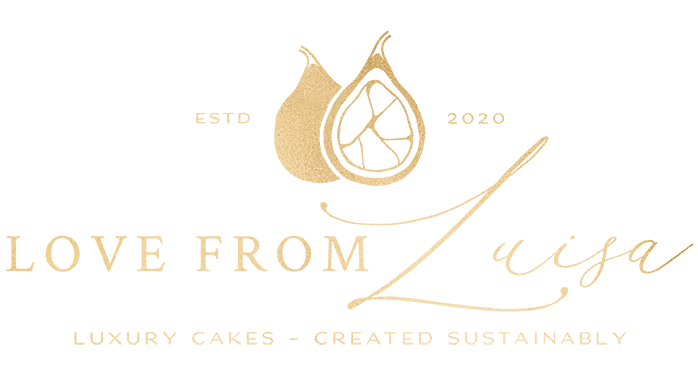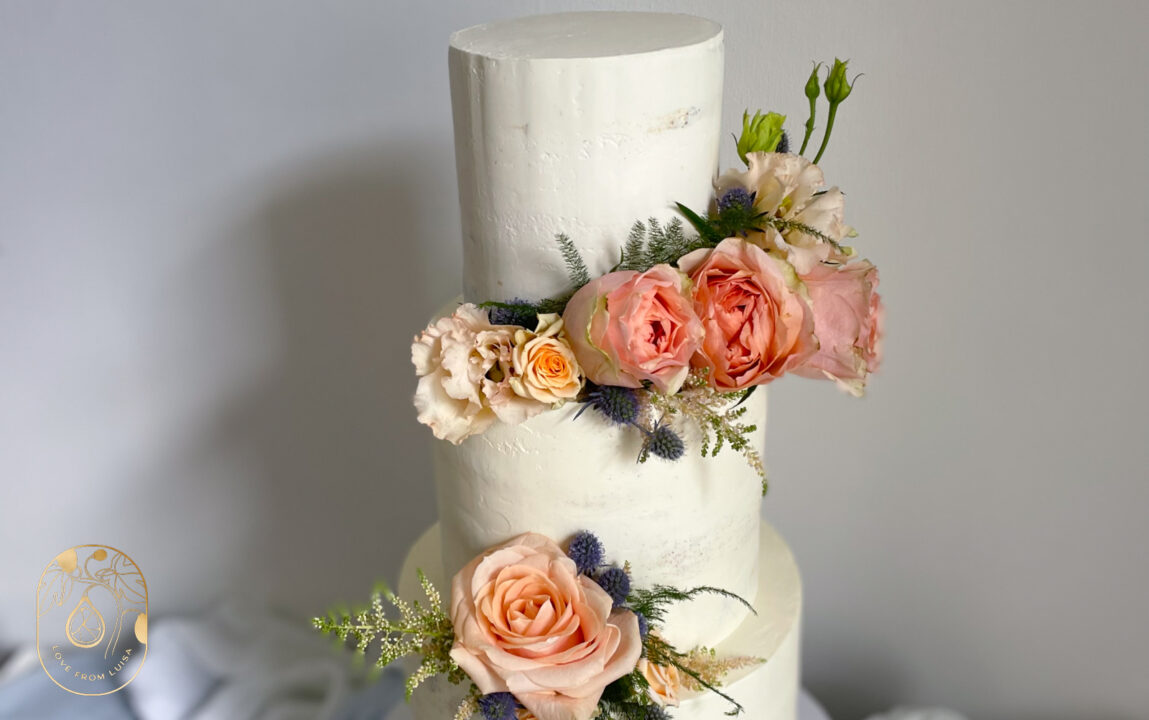
What Flowers Can You Use on a Wedding Cake?

Wedding Cake Flowers
What Flowers Can You Use on a Wedding Cake?
In recent times, the world of wedding cakes has seen some concern and confusion related to the use of fresh flowers as cake decorations. The Food Standards Agency (FSA) has introduced new legislation with guidelines about which flowers can and cannot be used on cakes for public consumption. These new guidelines (July 2023) are due to become law sometime in 2024.
The new guidelines and legislation will apply to all food products made for market consumption, including celebration cakes (even if they are given away for free as promotional material).
Navigating New Legislation and Liability For Wedding Cake Makers:
In light of new FSA legislation, I have written this blog post summarising the new rules around using fresh flowers and foliage on wedding cakes.
There are new guidelines from the FSA and Trading Standards in the UK stating that certain fresh florals should not be used on wedding cakes. This recommendation is currently in effect and is expected to become policy sometime in 2024. However, as professional cake makers, it is good practice to stay ahead of legislation because we do not want to use products that are not approved as safe for food use. Even if it is not technically illegal to do so.
At the end of this article, I give a list of the newly banned flowers and non-toxic flowers that can still be used to decorate wedding cakes, providing that they are treated correctly. I also give a list of fully edible flowers that can be placed directly onto cakes without concern. This is by no means exhaustive. I am not an expert in horticulture and you must do your own research when sourcing and using fresh flowers for any food purposes.
I have included links to some helpful resources including The Business of Baking Podcast episode: The Definitive Guide To Putting Fresh Flowers on Cakes and Bronya and Sammie’s email correspondence from the FSA which outlines the new guidelines more clearly.
Current best practice for using fresh flowers on a wedding cake:
Currently, the best practice is to ensure that you properly clean, treat, and wrap all fresh flowers and foliage intended to come into contact with (or even near) food. You should always clean the petals and leaves thoroughly and create a barrier between any petals or leaves that come into direct contact with the cake.
My Process:
I use melted cocoa butter and shea butter for this purpose. You need to wrap the stems of the flowers in floral tape, ensuring that you seal the stems, before inserting them into a (food-safe) posy pick. Taking these precautions should ensure that the flowers do not come into direct contact with the cake. However, once the new legislation comes into force using florals from the banned category on food products would make you liable, regardless of how they are treated and prepared.
Why is there new legislation regarding what flowers can be used on a wedding cake?
It is a bit unclear why this legislation is being enforced right now given that “the use of flowers on foods such as wedding cakes is well-established” (Email from FSA). However, The UK has some of the toughest Food Standards regulations in the world. And laws surrounding allergen communication, cross-contamination and food labelling have been getting stricter and stricter for some time. It is unclear if the USA, Australia and Europe will move to implement tougher legislation on what flowers you can use on a wedding cake. But we have to assume that the FSA have enacted this new legislation to keep the public safe from harm. So, even if it seems a little harsh, especially given that other countries do not implement the same standards, professional cake makers are all working towards the same goal… not to make our customers, or any member of the general public, sick.
So, even though you may continue to see people using these soon-to-be-banned florals on social media such as Instagram, these accounts may be based in the States or other countries with less stringent laws surrounding food safety.
A Crucial Question of Liability:
With whom does the liability lie for the flowers that you use on a wedding cake?
The pressing question is, who bears the responsibility for ensuring that the flowers adorning a wedding cake are safe, non-toxic, and prepared appropriately? Is it the cake maker or the florist providing the flowers? The answer to this is straightforward – if you are a cake maker crafting cakes for the market, you are solely accountable for each cake’s safety, even if it’s not sold for profit, such as when given away as promotional items.
Collaboration with florists:
The florist, while legally responsible for the overall safety of the materials they provide is not responsible for Food Safety. While clients should collaborate with the cake maker’s efforts to obtain non-toxic foliage, the cake maker bears the liability. Effective communication between the florist and cake maker should eliminate any worries regarding customer or public safety.
Due Diligence is Key:
You can design a formal sign-off sheet for the florist to confirm they’ve taken the essential precautions with the wedding cake flowers. Both parties being on the same page substantially reduces any potential liability issues. Historically, cake makers have been responsible for assessing materials for food contact, including flowers and vegetation. Without documented proof of safety, the responsibility still remains with the cake maker and I’d rather not take any chances so I personally treat the flowers before using them on a wedding cake.
Communicating new legislation to clients
How do you communicate What Flowers you can use on a Wedding Cake to your clients?
As professional cake makers, we should have Public Liability Insurance, typically with a minimum coverage of 5 million. Nonetheless, inadvertently causing illness in a member of the public could have dire consequences for a small business. It is every cake maker’s worst nightmare to inadvertently make a member of the public sick, so it is in everyone’s best interest to avoid potentially harmful foliage and this should be expressed clearly to your clients.
While your clients may still bring you wedding cake design ideas featuring fresh flowers, it’s essential to clearly communicate why adding fresh Eucalyptus, for example, is not possible. This is a crucial step to address business liability concerns, even if you still draw inspiration from Pinterest and other social media platforms that have not caught up with current legislation.
My advice would be to create a document explaining the new legislation. This can include your concern for public safety and ultimately your professional responsibility to keep members of the public safe. I also recommend creating a paragraph in your Terms and Conditions explaining the risks involved in using any flowers that are not 100% edible and food-safe. Serving to reduce the liability involved if your client still insists on using fresh non-toxic flowers on the wedding cake.
Cost
The biggest impact for most cake makers and their customers will be the cost of finding an alternative to fresh flowers for a wedding cake design. Using fresh flowers for wedding cakes is a relatively low-cost option for couples who already have to consider their budget. Creating wafer flowers and fondant decorations is extremely time-consuming, and the cost reflects the time and skill involved. This new legislation from the FSA has come at a difficult time for cake makers. The costs of running a cake business have increased significantly recently making it a challenging time for the industry. But we have to roll with the punches and ensure that we are fully compliant like any food business.
I would suggest creating alternative designs that do not use flowers on a wedding cake. Although this may seem like a limitation it can actually unleash your creativity and get you and your client to go for something new and interesting.
Here are my top 3 wedding cake designs that do not use fresh flowers:
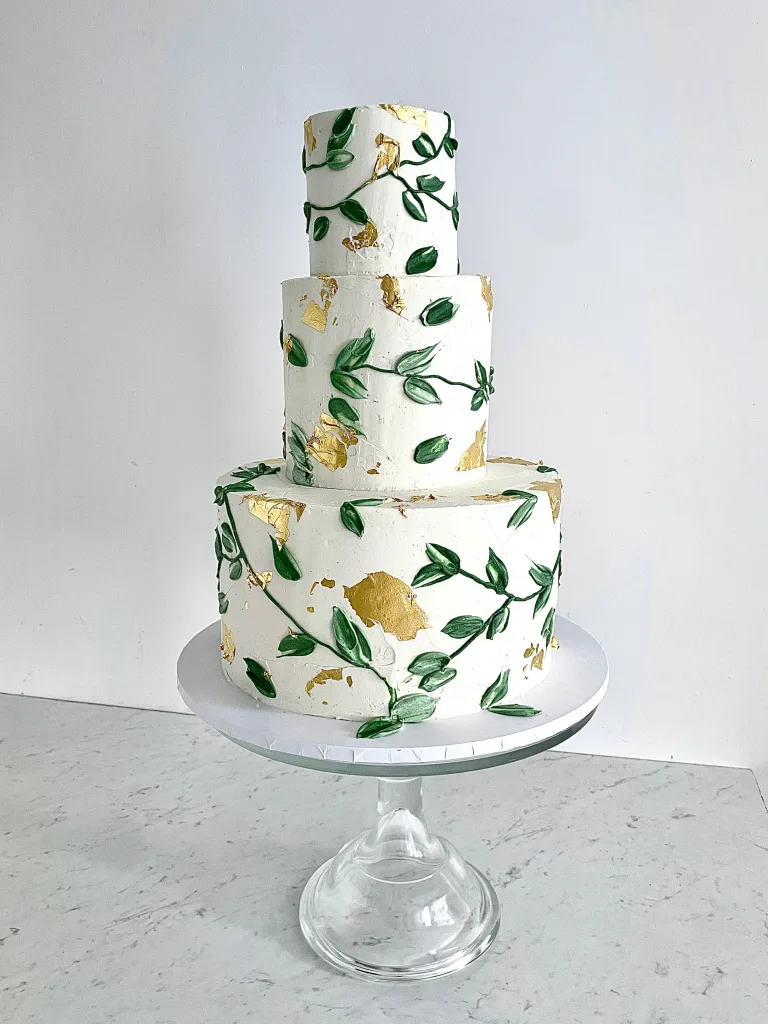
Buttercream painted greenery or flowers:
The possibilities are endless with painted buttercream details. You can have the colours match the bouquet or in your favourite colour palette.
Add touches of metallic gold or silver or keep it neutral.
Wafer Paper Bouquet:
You don’t need to worry about using your favourite flower types when they are made from edible wafer paper!
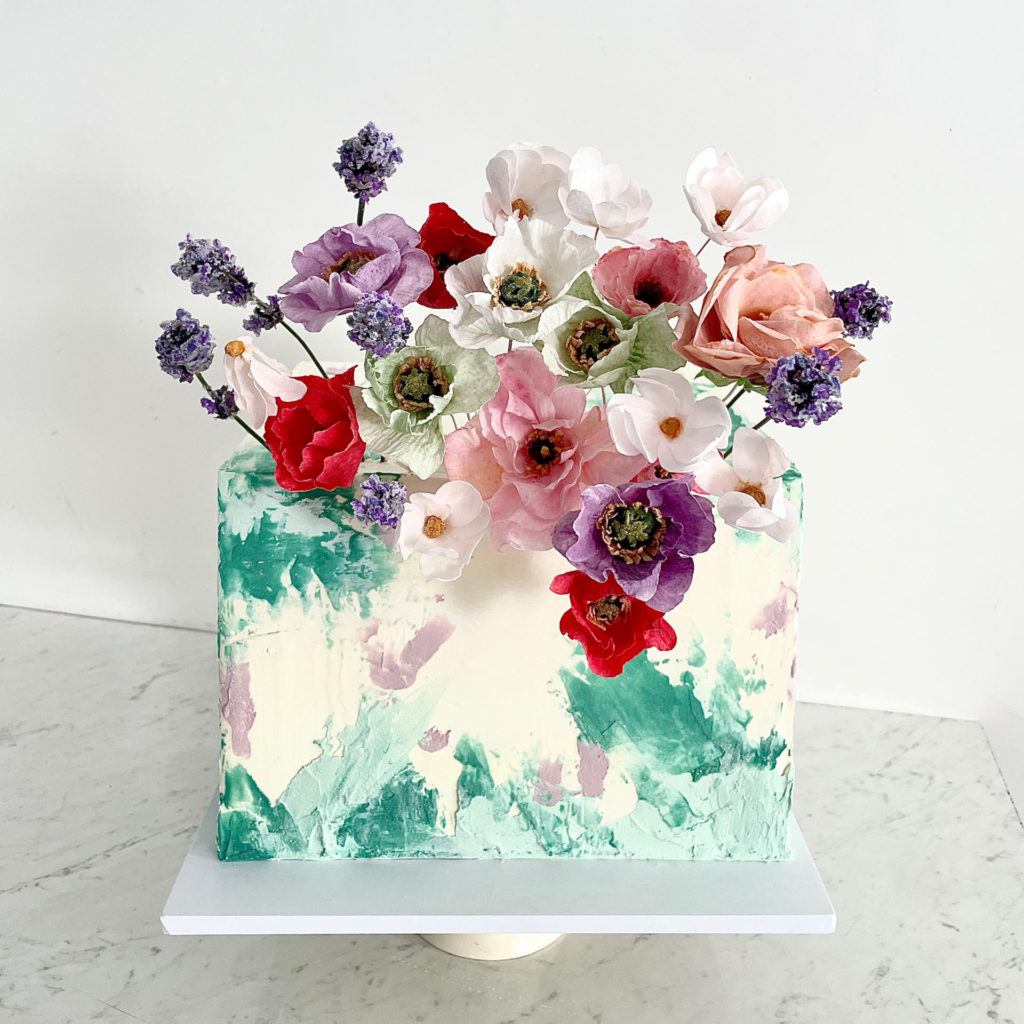
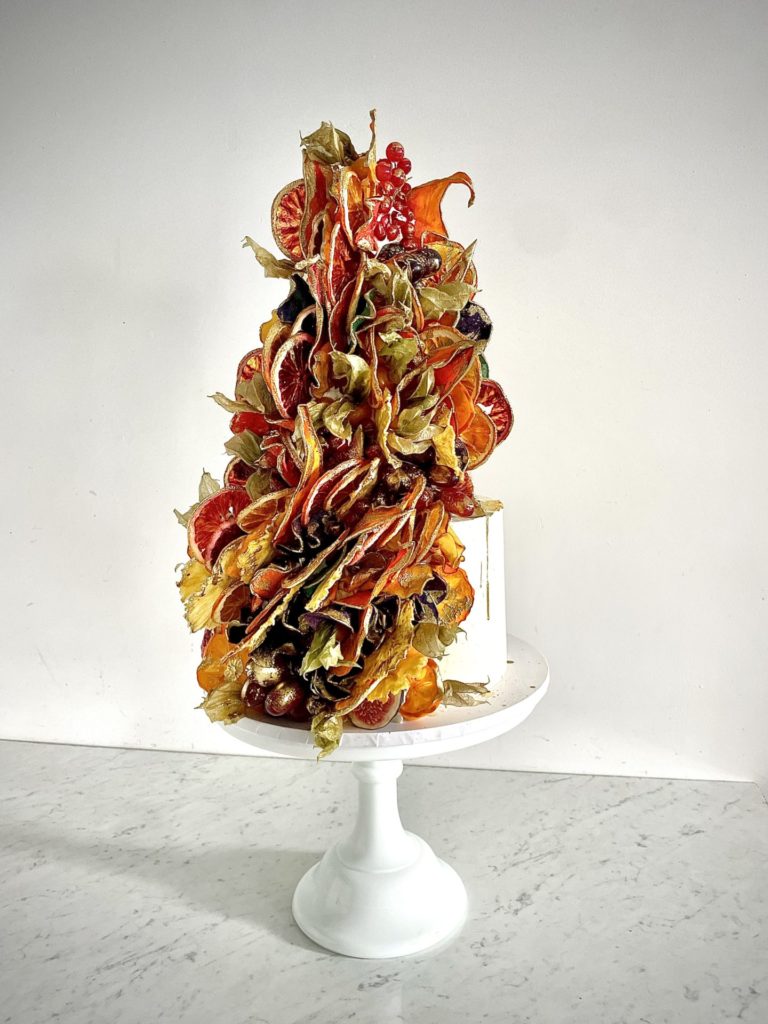
The Signature Fruit Petal:
At Love From Luisa, we create the Signature Fruit Petal design from hand-painted fruit petals and dehydrated citrus slices. The natural botanical fruits make each cake totally unique.
What Flowers Can You Use on a Wedding Cake?
You can add the following flowers to a wedding cake, provided they have been treated to be fully cake-safe and all due diligence has been carried out:
- Edible Flowers: Some flowers are fully edible and safe to place directly on wedding cakes. These include Alpine pinks, lavender, elderflower, primrose, sunflower, bergamot, day lily, nasturtium, rose, sweet violet, daisy, hibiscus, marigold, scented geranium, tiger lily, and chrysanthemums. However, it’s important to research and ensure that all parts of these flowers used are edible.
- Non-Toxic Flowers: Certain flowers are considered non-toxic and can be used on wedding cakes if they are properly prepared. This list includes roses, lisianthus, freesia, peony, cosmos, gerberas, cornflowers, dahlia, orchids, and lavender.
- Non-Toxic Greenery: Herbs like rosemary, sage, and thyme are generally safe to use, as are willow, wheat leaves (found with non-toxic flowers), spider plants, and furs and ferns. However, be aware that some of these can cause skin irritations, so take precautions.
*I got the list of edible flowers from Royal Horticultural Society. They also give lots of relevant information on potentially toxic plants.
Flowers You Can not Use on a Wedding Cake when the New Legislation is enacted:
- Banned Flowers: Several flowers will be banned by 2024 for use on wedding cakes. These include gypsophila, any lily, daffodils, rhododendron, delphiniums, eucalyptus, hydrangea, English yew, ranunculus (including buttercups), anthurium, calla lily, foxglove, mistletoe, and poppy.
In Summary:
The responsibility for ensuring the flowers on a wedding cake are safe, non-toxic, and properly prepared lies with the cake maker. Collaborating with the florist and having them acknowledge the necessary precautions can help reduce liability issues.
Communication with clients is key. It is important to explain the new legislation, express concern for public safety, and outline professional responsibility in terms and conditions.
While using fresh flowers may be cost-effective, you can consider alternatives like wafer flowers or fondant decorations. Although these may be more time-consuming and costly, keeping your client safe and your liability to a minimum is essential.
Overall, ensuring the safety and well-being of customers is a top priority for professional cake makers, and staying compliant with food safety regulations is essential.
More Resources:
Here are some really helpful resources for determining what flowers you can use on a wedding cake:
- Food Contact Materials Regulations from the FSA
- The Business of Cake Making: https://daisycakecompany.co.uk/the-definitive-guide-to-putting-fresh-flowers-on-cakes/
- Email correspondence from FSA regarding cake flowers courtesy of Daisy Cake Company: Email
- Royal Horticultural Society: List of Edible Flowers
- Royal Horticultural Society: List of Potentially Harmful Flowers
